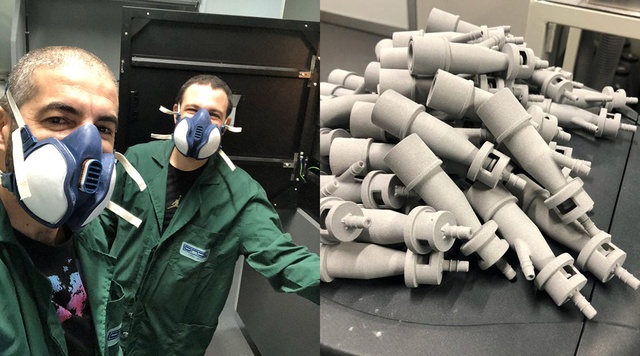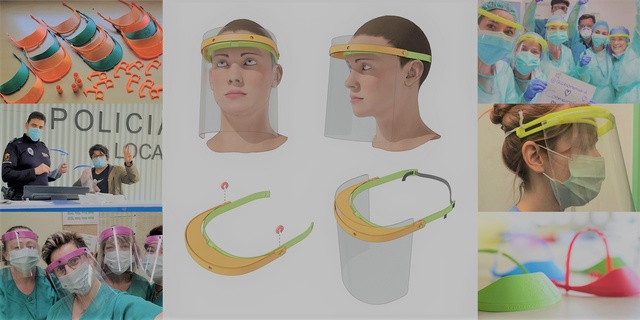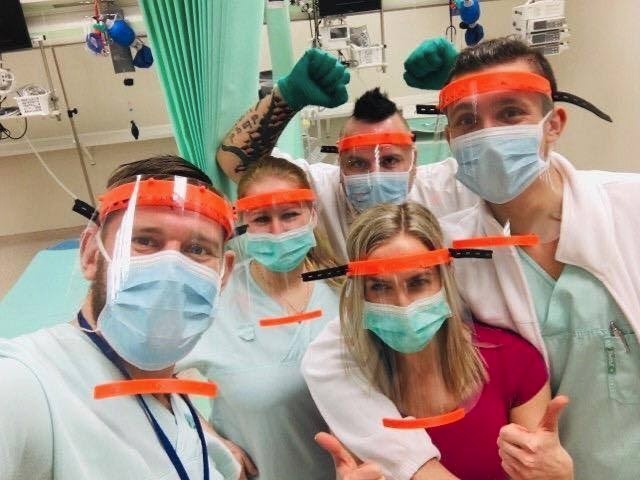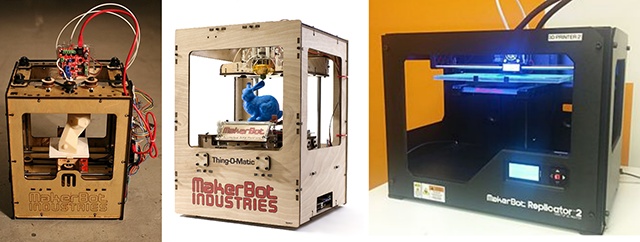Future of Design: Keep calm, stay home and 3D print
The fourth in our Future of Design series – which looks at how new and changing technologies are affecting the architecture, engineering and construction (AEC) industries – sees Maria Mingallon explore how designers all around the world have united to fight the COVID-19 pandemic using at-home 3D printers and ask what decentralised manufacturing could mean for our collective future.

In my last article, I promised you all a sequel on examples of artificial intelligence applications in the architecture, engineering and construction industry. Rest assured that is still on my mind but the extraordinary times we live in urge for a change of direction in my original plan.
New Zealand announced emergency level 4 and made the lockdown measures effective at midnight on Wednesday 25th March. Like most of you reading this article, we closed down the office and made ourselves ready to ‘work from home’. I was not surprised by these measures, having seen how rapidly SARS-cov-2, the virus responsible for the COVID-19 pandemic, was advancing overseas. In Spain, where my family lives, the virus has already taken the lives of 18,579 people. Imagine the entire population of Queenstown and Matamata gone, in less than eight weeks since the first two cases were detected on 15th February. In accordance with the Open Source COVID19 Medical Supply Guide, if infections proceed at the same pace as across the globe, we would not have enough medical supplies to prevent the high mortality rates countries like Italy, Spain and USA have seen so far.
A filament of hope
The weekend before lockdown measures were officialised in New Zealand, as I finished talking to my parents on WhatsApp, a bold thought crossed my mind: “perhaps we could 3D print masks…”. What a crazy and desperate idea, I thought to myself. Thankfully, curiosity won. I turned again to my phone to search for “3D print COVID-19 masks”. A spark of hope replaced the fear, frustration and hopelessness I had been experiencing for the past few weeks when I saw there was an emerging community of designers and makers uniting alongside health professionals to fight COVID-19.
I first came across a short article featuring Cristian Fracassi and Alessandro Ramaioli at their tech startup Isinnova. They started 3D printing Venturi valves for respirators to help out a hospital in Brescia, Italy. From there, I then discovered a public spreadsheet called 3D Printer Crowdsourcing for COVID-19 which had just been published four days before, on 16th March. It was a simple Google Docs spreadsheet, which has now moved to a Google form, created for 3D printing professionals and hobbyists alike to volunteer their time and resources to print masks, valves, or whatever else hospitals were running short on. Two days later, there were already more than 4,800 volunteers on the list from all over the world. I was one of them.

Image 1: Cristian Fracassi and Alessandro Ramaioli at their tech startup Isinnova from where they had 3D printed Venturi valves for respirators. (Source)
My next search led me to discover that even my birth town in Spain, Ciudad Real, a small town of just 70,000 people in the middle of La Mancha, had a fast-growing community of 220 makers. I was thrilled to see how in just four days, makers all around the world had self-organised to fast track the prototyping and production of open source personal protective equipment (PPE) such as face shields, masks, respirators and even straps to save the ears of those having to wear face masks all day long.

Image 2: Unlike other PPE (Personal Protective Equipment) required to fight COVID-19, face shields have been first to obtain approval from most health institutions. As a result, the great majority of makers are currently focusing on fabricating face shields while they wait for approval on masks and respirators. (Source)

Image 3: Ear savers straps featuring supportive messages for those working in first respondent services and having to wear masks all day long. Some of the messages featured are: ‘Superhero’; ‘Superheroine’; ‘You can’; ‘Hero at work’; ‘Heroine at work’; ‘Stay strong’; ‘You are great’. These are from the makers in Ciudad Real and Extremadura, both in Spain. (Source) (Source)
What amazed me even more was that they did it all from their homes, communicating via virtual working apps such as Slack, Discord or Telegram. The pace at which they were able to exchange files, get feedback on the prototypes, develop their designs and collaborate with each other was extraordinary. Most of them had not even met in person and yet they were able to work together seamlessly united by a common goal, like a swarm of small fish in the presence of a predator. While most large businesses around the world are struggling to remain productive during lockdown conditions, these so-called hobbyists are actually flourishing at an unprecedented speed.

Image 5: Snapshot of one of the channels on Discord from the coronavirus makers of Australia and New Zealand, locally known as the Open Manufacturing Alliance. (Source: Open Manufacturing Alliance group on Discord)
A hidden factory that saves lives
According to the World’s Health Organisation (WHO), supplies can take months to deliver and market manipulation is widespread, with stocks frequently sold to the highest bidder. Based on WHO modelling, an estimated 89 million medical masks are required for the COVID-19 response each month. To meet rising global demand, WHO estimates that industry must increase manufacturing by 40 per cent.
“Without secure supply chains, the risk to healthcare workers around the world is real. Industry and governments must act quickly to boost supply, ease export restrictions and put measures in place to stop speculation and hoarding. We can’t stop COVID-19 without protecting health workers first,” says WHO Director-General, Dr Tedros Adhanom Ghebreyesus.
By 29th March – that is not even 10 business days since the first public spreadsheet was published – the Spanish ‘coronavirus makers’ alone had fabricated and delivered over 350,000 face shields to those working in essential services. In only two weeks after its birth, the coronavirus makers network had 16,4000 soldiers fabricating and distributing 41,000 units a day. This is one of the unforeseen benefits of decentralized manufacturing empowered by 3D printing, as this rather large community of makers can produce thousands of components using the same files and quality assurance standards, all while maintaining social distancing protocols to minimize the spread of the disease.

Image 6: Face shields produced by local communities of makers all throughout Spain, including those in Ciudad Real. (Source – top left) (Source)
Seeing the shortages of sanitary equipment experienced elsewhere in the world, the Open Manufacturing Alliance in Australia (OMA-AUS) is providing integrated and responsive supply chain solutions, through a decentralised platform for rapid manufacturing responses. Queensland health authorities mobilised Brisbane’s 3D printing businesses to create 3,000 essential face shields in just five days. “Currently our PPE supplies across Queensland’s public health system are enough. But that won’t last forever, which is why increasing local manufacturing is so important,” said Steven Miles, Queensland Health Minister.
Aotearoa, New Zealand is also acting surely in this space and has rapidly created ShieldsUpNZ – a site to facilitate the open source fabrication of face shields to protect Kiwi first responders. Whether you are a company or an individual, if you have access to a 3D printer in New Zealand, ShieldsUpNZ needs your help. Having access to a local supply of COVID-19 PPE will help those in essential services keeping infection and mortality rates as low as we are currently seeing them in New Zealand.
The design of the open source face shield in New Zealand comes from Josef Prusa, founder of Prusa Research, and pioneer of one of the first and best-regarded DIY desktop 3D printers (Prusa i3). Prusa has been working pro bono with the Czech medical authorities since the outbreak to refine the design of the face shield to suit their needs. He did not hesitate to make their design open source and offer it to the rest of the community of makers worldwide to ease the shortage of PPE.

Image 7: Find out more about how you can help your local community of makers at Shields Up New Zealand.
The future we make
The term ‘maker’ was first used by the magazine Make in 2005. Make was born with a mission to celebrate and nurture the maker culture and its creative spirit. It followed the momentum created by the first DIY desktop 3D printer, the RepRap, released in 2004 by Dr Adrian Bowyer. At only 400EUR, compared to 19,000EUR, the RepRap revolutionized the world of rapid prototyping. Owning a 3D printer became a dream come true for lots of hobbyists who had used the technology in prototyping shops and labs but who never thought they would ever be able to afford one for their personal use.
The Reprap movement was soon followed by MakerBot Industries, a Brooklyn based startup founded in 2009 by Bre Pettis, Adam Mayer, and Zach “Hoeken” Smith. They created one of the most popular desktop 3D printers of all times, the Replicator. As of April 2016, MakerBot had sold over 100,000 desktop 3D printers worldwide. I have owned one of those since January 2013.

Image 8: From left to right, in order of appearance, the Cupcake CNC (2009), the Thing-O-Matic (2010) and finally, the Replicator 2 (2012). At the time of its release, the Thing-o-matic was the favoured desktop 3D printer utilised by maker communities, universities and small businesses. It featured an improved design from the original Cupcake CNC, easier to build and far simpler for inexperienced users to troubleshoot. (Source)
Alongside the various versions of the Replicator, they also founded Thingiverse, the largest online 3D printing community and file repository. Makers of all sorts can share, download, print, test and improve designs on Thingiverse from all over the world. Even if you have zero skills in 3D modelling, you can still freely access or purchase ready-to-print files to make a myriad of ‘things’, from a stand to rest your phone during a videoconference to replicas of your favourite Marvel heroes.
RepRap, MakerBot, Prusa, and all those who have since followed, are bringing the tools of manufacturing to the masses and supporting creative people so they can make anything. Sixteen years from its humble beginnings, the Maker Movement has the potential to change the future of work, product development, education, learning, and more.

Image 9: Timeline of the Maker Movement according to the magazine Make. (Source)
What if?
Factories, as we know them now, arose with the Industrial Revolution when capital and space requirements became too great for sheds or workshops, in part because of the need to house large heavy-duty machinery. What if the ‘factory of the future’ consisted of a network of decentralised 3D printers which could seamlessly be accessed by consumers or designers using an online platform?
New Zealand’s based startup, Ponoko, brings us an interesting proposition. Consumers can design their products using a starter kit design software, purchase design blueprints or download some free of charge depending on their intended use. If they count with a personal 3D printer or fabrication space, they can manufacture their own product, cutting down labour and shipping costs. Alternatively, they can easily book 3D printing facilities nearby and have a maker do the fabrication for them, all online and from the comfort of their home or headquarters.
Ponoko is not alone. Founded in 2007 and headquartered in New York City, Shapeways hosts today the largest and most sophisticated online collection of ready-to- be-printed designs, ranging from toys to machine parts. From strong plastics to polished metals, Shapeways catalogue of materials is mind blowing, including precious metals such as gold, silver, copper, platinum and many more. As a consumer, you can select a design from a designer’s storefront or create your own using their proprietary design tools.
Like Amazon or eBay, both Ponoko and Shapeways offer storefronts for third party merchants such as designers. Instead of selling manufactured products, they sell design blueprints and rent out remote machines to make them. Could decentralised fabrication lower the need to ship large quantities of raw materials across oceans? Could local production cut down long distance shipping to get from the factory to the consumer? And in doing so, could local, decentralised manufacturing lower our carbon emissions?
COVID-19 has turned the world we have built upside down, exposing the weaknesses of our current supply chain. In doing so, it has also revived a network of worldwide makers who have decided to step up to the challenge. It is events of this magnitude that remind us of how fragile and yet resilient we can be. We shall not take it lightly and learn from it. We shall not forget that we are always responsible for the future we decide to make.
‘The Future We Make’ featuring the Maker Faire, at the heart of the Maker Movement since 2006 through live events, learning initiatives & storytelling.
Catch up on the others in the Future of Design series here.









